Starting a coffee shop is a dream for many. However, running a successful café is more than just brewing good coffee; it requires a solid foundation in business fundamentals. Let’s explore the top 5 reasons why coffee shops fail in the U.S. in their first year, so you can steer clear of these pitfalls.

1. Poor Management
- Hiring Mistakes: Many coffee shop owners hire staff based solely on availability, not on shared values. Hiring without a values-based approach often invites “bad apples,” leading to issues like theft, free handouts to friends, and a toxic workplace environment. Such missteps hurt morale, increase turnover, and ultimately cost you thousands in hiring and training.
- Inventory Mismanagement: Ordering too little leads to missed sales, while over-ordering leads to spoilage. Poor inventory control raises your cost of goods sold, eating into profits. Efficient inventory management is crucial for keeping costs in check.
- Vendor Relations: Vendors aren’t just suppliers; they’re partners. Mismanaging these relationships can backfire, especially when you need support. Building strong vendor partnerships can secure your supply chain in times of crisis, ensuring that your coffee shop operates smoothly.
2. Wrong Location
- High Traffic or Residential Areas: Coffee shops rely heavily on foot traffic to sell low-ticket items like coffee. Choosing a location with either high foot traffic or dense residential areas is essential. If you can’t afford prime spots, consider neighborhoods where customers are likely to use third-party delivery services.
- Neighborhood Characteristics: Accessibility and safety are critical. A shop targeting students should be near public transit, while family-friendly locations should be in safe neighborhoods. Understanding your location’s characteristics can help you make the most of what it offers.
3. Lack of Uniqueness
- Creating a Memorable Experience: If your coffee shop doesn’t stand out, why should customers choose it over home-brewed coffee? Offering a unique experience—whether it’s a cozy, homelike vibe or a sophisticated setting—helps you occupy a special place in customers’ minds. Being different is what will keep
4. Not Knowing the Numbers
- Financial Awareness: Many shop owners see cash coming in but overlook the finer details, such as break-even rates, average order values, and turnover. Knowing your numbers helps you identify ways to maximize profitability, like introducing complementary food items, optimizing staff shifts, or adjusting hours to reduce costs.
- Profitability Strategies: Analyzing each product’s cost and profit margin is key. Sometimes, lower-priced items with lower costs yield the same profit as high-priced items, allowing you to sell more and increase revenue without extra overhead.
5. Mindset and Growth
- Learning and Adapting: A lack of a growth mindset can hinder success, especially in a fast-evolving industry like food service. Staying updated with marketing strategies—whether through email, social media, or SMS marketing—and engaging with industry communities helps coffee shop owners adapt and grow.
Understanding these five common pitfalls will equip you to make smart choices, helping you avoid being part of the 75% of coffee shops that fail within their first year in the U.S. Focus on strong management, strategic location, unique offerings, financial knowledge, and a growth mindset to thrive in the coffee industry.








